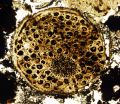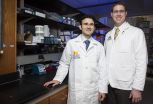(Press-News.org) Scientists have developed an approach to creating treatments for osteoporosis and autoimmune diseases that may avoid the risk of infection and cancer posed by some current medications.
Researchers at Washington University School of Medicine in St. Louis redesigned a molecule that controls immune cell activity, changing the molecule's target and altering the effects of the signal it sends.
Current treatments for bone loss and autoimmune disorders block these molecules and their signals indiscriminately, which over time increases the risk of infections and cancer. The new approach may let scientists selectively block the bad signals that cause or contribute to disease and enhance good signals that defend the body against cancer and infections such as tuberculosis.
"The molecule we studied controls cells linked to bone weakening, but it belongs to a family of proteins implicated in conditions such as rheumatoid arthritis, psoriasis, Crohn's disease and asthma," said first author Julia Warren, an MD/PhD student. "Therefore, this has broad implications for how we might design therapies for a wide variety of ailments."
The findings appear online in Science Signaling.
The researchers worked with RANKL, a protein that activates cells that dismantle bone. Normally this makes it possible for another group of cells to rebuild the bone, renewing the skeleton and maintaining its strength as the body ages. But if the bone dismantlers become more active than the bone builders, weakening of the skeleton and bone loss result.
Co-senior authors Steven Teitelbaum, MD, and Daved Fremont, PhD, showed that copies of RANKL naturally come together in clusters of three. To send a signal, which triggers the development of bone-dismantling cells, each copy of RANKL in the cluster has to bind to a copy of a receptor, which passes on the signal.
To see if they could take advantage of this requirement, the researchers mutated individual copies of the RANKL protein to make them better or worse at hooking up with the receptor. They then joined together two copies of the protein that were very good at attracting and holding onto the receptor with a third copy that did not bind to the receptor.
"When we gave this to mouse cells, naturally occurring RANKL couldn't compete with the drawing power of engineered RANKL," said Teitelbaum, the Wilma and Roswell Messing Professor and director of the Division of Anatomic and Molecular Pathology. "But the new clusters still couldn't send a signal because the third copy of the protein in each cluster was unable to connect to the receptor."
The new clusters kept two copies of the receptor busy trying to open the signaling circuit without ever letting a third copy of the receptor finish the process. Consequently, formation of bone-degrading cells was blocked. When the scientists injected mice with the new clusters, the mice stopped making the cells and breaking down bones.
In contrast, injecting copies of the cluster in which all copies of the protein latched tightly to the receptor increased the activity of the bone-dismantling cells.
The researchers also worked with a naturally occurring decoy receptor for RANKL. When this receptor binds to the protein, it blocks its signal. This decreases the number of times the signal is sent.
"A major design challenge for our project was to develop a version of RANKL that would not bind to this decoy receptor," said Fremont, an associate professor of pathology and immunology. "Julia was able to select versions of RANKL that were significantly better at binding to the normal receptor but were nevertheless incapable of binding to the decoy receptor."
According to the researchers, their ability to do this suggests the approach may help design treatments for other diseases that are controlled by similar mechanisms.
"That's the home run here," Teitelbaum said. "This is a way we can selectively activate one receptor and block another."
INFORMATION:
Funding from the National Institutes of Health (NIH) (AR032788 and F30 AG039896) supported this research.
Warren JT, Nelson CA, Decker CE, Zou W, Fremont DH, Teitelbaum SL. Manipulation of receptor oligomerization as a strategy to inhibit signaling by TNF superfamily members. Science Signaling, Aug. 19, 2014.
Washington University School of Medicine's 2,100 employed and volunteer faculty physicians also are the medical staff of Barnes-Jewish and St. Louis Children's hospitals. The School of Medicine is one of the leading medical research, teaching and patient-care institutions in the nation, currently ranked sixth in the nation by U.S. News & World Report. Through its affiliations with Barnes-Jewish and St. Louis Children's hospitals, the School of Medicine is linked to BJC HealthCare.
Discovery may lead to better treatments for autoimmune diseases, bone loss
2014-09-25
ELSE PRESS RELEASES FROM THIS DATE:
Fossil of multicellular life moves evolutionary needle back 60 million years
2014-09-25
A Virginia Tech geobiologist with collaborators from the Chinese Academy of Sciences have found evidence in the fossil record that complex multicellularity appeared in living things about 600 million years ago – nearly 60 million years before skeletal animals appeared during a huge growth spurt of new life on Earth known as the Cambrian Explosion.
The discovery published online Wednesday in the journal Nature contradicts several longstanding interpretations of multicellular fossils from at least 600 million years ago.
"This opens up a new door for us to shine some light ...
NCI/FDA lung cancer workshop leads to the innovatively designed clinical trials
2014-09-25
DENVER – The recent launch of two clinical trials offer innovative study designs for patients with lung cancer. These clinical trials are the direct result of a National Cancer Institute (NCI) sponsored workshop chaired by Drs. Fred R. Hirsch, Shakun Malik and Claudio Dansky- Ullman, that brought together the NCI Thoracic Malignancies Steering Committee, the US Food and Drug Administration (FDA), academicians, clinicians as well as industry and government stakeholders to discuss issues and challenges related to clinical trial design and biomarkers for lung cancer targeted-therapies.
The ...
Treatment studied to help patients 'burned to the bone'
2014-09-25
An anti-inflammatory treatment, studied in the labs of regenerative medicine specialists and trauma surgeons, may prevent what's become one of the war-defining injuries for today's troops.
Those burned by high-velocity explosive devices are at-risk for heterotopic ossification (HO), in which bone develops in places it shouldn't be, outside the skeleton, in joints, muscles and tendons. The painful condition can make it difficult to move and function and commonly affects patients who suffer burns, automobile accidents, orthopedic surgery and blast injuries and other combat ...
Live long and phosphor: Blue LED breakthrough for efficient electronics
2014-09-25
ANN ARBOR—In a step that could lead to longer battery life in smartphones and lower power consumption for large-screen televisions, researchers at the University of Michigan have extended the lifetime of blue organic light emitting diodes by a factor of 10.
Blue OLEDs are one of a trio of colors used in OLED displays such as smartphone screens and high-end TVs. The improvement means that the efficiencies of blue OLEDs in these devices could jump from about 5 percent to 20 percent or better in the near future.
OLEDs are the latest and greatest in television technology, ...
Study finds global sea levels rose up to 5 meters per century at the end of the last 5 ice age
2014-09-25
Land-ice decay at the end of the last five ice-ages caused global sea-levels to rise at rates of up to 5.5 metres per century, according to a new study.
An international team of researchers developed a 500,000-year record of sea-level variability, to provide the first account of how quickly sea-level changed during the last five ice-age cycles.
The results, published in the latest issue of Nature Communications, also found that more than 100 smaller events of sea-level rise took place in between the five major events.
Dr Katharine Grant, from the Australian National ...
Calming down immune cells could hold key to melanoma treatment
2014-09-25
Immune cells may be responsible for drug resistance in melanoma patients, according to research published in Cancer Discovery.
Cancer Research UK scientists at The University of Manchester found that chemical signals produced by a type of immune cell, called macrophages, also act as a survival signal for melanoma cells.
When the researchers blocked the macrophages' ability to make this signal - called TNF alpha - melanoma tumours were much smaller and easier to treat.
When melanoma patients are given chemotherapy or radiotherapy it causes inflammation, increasing ...
Interactive website helps lower-income smokers to stop smoking
2014-09-25
People with lower incomes attempting to quit smoking are 36% more likely to succeed if they use a new interactive website called 'StopAdvisor' than if they use a static information website, finds a randomised controlled trial led by UCL researchers. The trial was funded by the National Prevention Research Initiative, a consortium of 16 UK health research funders.
A total of 4,613 smokers took part in the study, of whom 2,142 were classified into a 'lower income' group who had never worked, were long term unemployed or from routine or manual occupations (lower socioeconomic ...
Skirt size increase linked to 33 percent greater postmenopausal breast cancer risk
2014-09-25
Overall weight gain during adulthood is known to be a risk factor for breast cancer, but a thickening waist seems to be particularly harmful, indicating the importance of staving off a midriff bulge, the research shows.
The researchers base their findings on almost 93,000 women taking part in the UK Collaborative Trial of Ovarian Cancer Screening (UKCTOCS) in England.
The women were all aged over 50, had gone through the menopause, and had no known breast cancer when they entered the study between 2005 and 2010.
At enrolment they provided detailed information on height ...
The Lancet Diabetes & Endocrinology: Working long hours linked to increased risk of type 2 diabetes
2014-09-25
People working for more than 55 hours per week doing manual work or other low socioeconomic status jobs have a 30% greater risk of developing type 2 diabetes, according to the largest study in this field so far, published in The Lancet Diabetes & Endocrinology.
Mika Kivimäki, Professor of Epidemiology at University College London, UK, and colleagues conducted a systematic review and meta-analysis of published studies and unpublished individual-level data examining the effects of long working hours on type 2 diabetes up to 30 April 2014.
Analysis of data from 4 published ...
Identification of genetic risk factors for stroke
2014-09-25
Stroke is one of the leading causes of death worldwide. While many lines of evidence suggest that stroke risk is heritable, only a small number of genes associated with stroke have been identified. A new study in the Journal of Clinical Investigation identifies two genes that underlie cerebral small-vessel disease (CSVD), a risk factor for stroke. Ordan Lehmann and colleagues at the University of Alberta analyzed genome-wide association data from individuals that received brain MRI scans as part of the Cohorts for Heart and Aging Research in Genomic Epidemiology (CHARGE) ...


